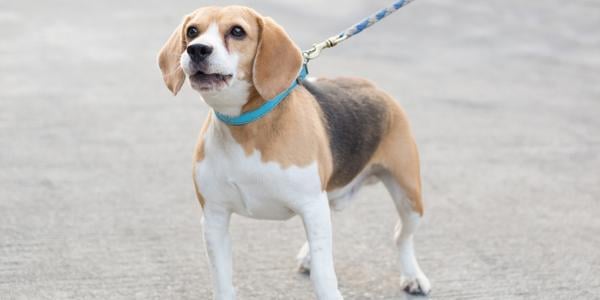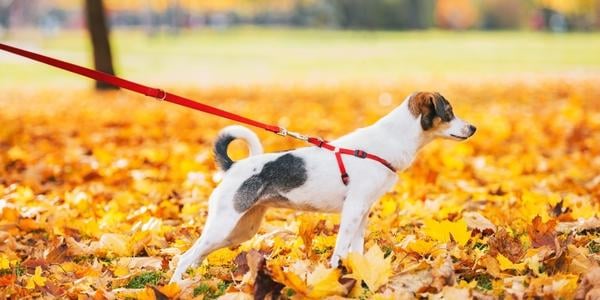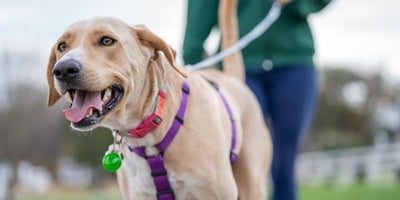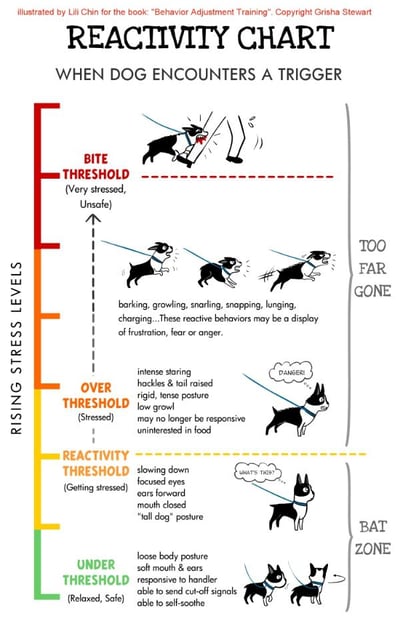 If walking your dog is a struggle because they lunge and bark at passers-by or other dogs, you're probably wondering where to start in tackling the overall problem. Not only can leash reactivity be dangerous, but it can be embarrassing for you and incredibly stressful for your dog!
If walking your dog is a struggle because they lunge and bark at passers-by or other dogs, you're probably wondering where to start in tackling the overall problem. Not only can leash reactivity be dangerous, but it can be embarrassing for you and incredibly stressful for your dog!
The good news is that there are ways to help your dog feel better about what frightens them and stop the barking and lunging at others. In this article, we'll look at one of my favorite methods that I start with for leash reactivity, fear, or anxiety — open bar, closed bar.
The open bar, closed bar dog training method is an effective and easy way to start helping your dog overcome leash reactivity or as a way to boost your puppy's socialization experiences. It's one of the foundational methods I teach in my Reactive Rover group classes because it focuses on changing negative emotions to positive ones, which in turn changes your dog's behavior.
Table of Contents
How Open Bar Closed Bar Works to Change Your Dog's Behavior
Creating and Changing Associations
This counterconditioning method has become especially popular since mentioned in the book Dogs Are From Neptune by Jean Donaldson, and is a simple way to create and/or change emotional associations with things in your dog's environment.
Different things happening in the dog's environment take on either positive, neutral, or negative associations. Dogs are making associations all of the time, and it's how they make sense of the world around them and then informs their behavior. If a dog feels unsure or frightened (negative emotions), then their behavior reflects that – often with defensive aggressive responses like barking or lunging to try and make the thing stop or go away.
The open bar closed bar method works to change negative associations to positive ones through the consistent pairing of something your dog finds overwhelming or frightening (what we call the "trigger") with something they find SUPER valuable and desirable.
When the "trigger" appears, continuous feeding of high-value treats begins. The bar is open!
The treats continue for as long as the trigger is present.
When the trigger goes out of sight, the treats stop. The bar is closed.
With consistency and repetition, your dog starts to associate the appearance of the trigger with good things happening to them. This emotional shift causes a shift in the behaviors your dog exhibits.
Positive Associations
For my own dogs, opening the refrigerator means the possibility for "cheese time" (which, unbeknownst to them also means pill-giving time). When I open the fridge, they happily run into the kitchen with anticipation of something they love. This is an example of a positive emotional response. The fridge opens = the potential for cheese! The same goes for when I grab their harnesses and leashes. They get excited because they love walks.
Neutral Associations
Many experiences can be neutral for a dog, where nothing good or bad has happened so that particular thing has no meaning either way for them. They don't exhibit particularly positive or negative behaviors when they see or experience it in the future. For example, my older dog doesn't care when a bicyclist passes us on walks because it's never been paired with anything bad or good for her. It just is.
Neutral associations are just fine! We don't need to make every experience a positive one, but we do want to avoid negative associations because it can increase fear or aggressive behavior, and no one wants their dog to feel overwhelmed or stressed.
Negative Associations
For some dogs, whether due to missed early socialization or previous traumatic experiences, the appearance of certain things has a negative association. For example, a dog is frightened when seeing another dog while on a walk. Because of the negative emotional association, they bark and lunge in an effort to scare it away.
A negative emotional response results in particular behavior choices that are undesirable from a person's point of view. This state of mind also causes increased cortisol (the stress hormone) in a dog's body, and increased stress can affect the long-term health of your dog.
The open bar closed bar method is useful for changing a variety of negative associations to positive ones. While I'll cover using it for dog-directed leash reactivity in particular further below, here are just a few other examples of how I use this for other issues:
- Introducing bathing and grooming, especially brushing or blow drying
- Part of a puppy's early socialization
- Alert barking in the home
- Territorial barking in the yard when people or dogs pass by
- Reactivity towards cars, bicycles, skateboards, buses, etc.
- Fear of people, whether on walks or with visitors to the home
- Sensitivity to sounds or certain types of noise anxiety
- Helping a dog feel better about household items, like the vacuum cleaner or coffee grinder
 How to Practice Open Bar Closed Bar with Your Dog
How to Practice Open Bar Closed Bar with Your Dog
What You'll Need
High-value treats: What treats you use for open bar closed bar should be reserved only for use around your dog's trigger(s), not something they get at other times.
My favorite treat option for this method is a squeezable treat tube so that continuous feeding is easier. My go-to options are the Bark Pouch treat pouches, which come in a variety of flavors and are more enticing and convenient than the homemade treat slurry that I could make at home. My dogs' current favorite is the sardines and cream cheese flavor.
Other high-value treat options include turkey hotdogs, low-fat string cheese, or squeeze can cheese. Aim for soft, squishy, smelly, and easy to give quickly!
For dogs with restricted diets or allergies, boiled chicken breast or low-fat string cheese can be an option. Check with your veterinarian about what they recommend for your dog's needs. But remember – your dog must find the food super enticing and valuable enough to help counteract a negative emotional association.
Open Bar Closed Bar Dog Training Sequence:
- A dog appears down the street.
- Start continuous feeding of high-value treats.
- Keep feeding for as long as the dog is in view.
- The dog disappears from view.
- Immediately stop feeding high-value treats.
You do not need to ask your dog to do anything! This method has nothing to do with what your dog is doing, it's all about changing how your dog is feeling.
Your dog doesn't need to be looking at you, sitting, or anything "action"-wise. This is only about the trigger predicting food. Strictly classical conditioning. No need to use a clicker or marker word in this method either.
Stay Under Threshold
 For effective and faster behavior change using the open bar closed bar method, you'll want to stay at a distance from the trigger where your dog notices it but isn't already barking. We call this "under threshold."
For effective and faster behavior change using the open bar closed bar method, you'll want to stay at a distance from the trigger where your dog notices it but isn't already barking. We call this "under threshold."
If a dog is too close to the trigger, or the trigger is too intense (such as a sound that's too loud), a dog will typically not take food no matter how good it is, and their brain is not in a state of learning. This happens because their nervous system switches from parasympathetic to sympathetic.
- The parasympathetic nervous system is in charge of "rest and digest."
- The sympathetic nervous system is in charge of "fight or flight."
If your dog is in flight-or-fight mode, their appetite is suppressed, and changing associations is incredibly difficult.
However, with that being said, if a trigger suddenly appears (as can happen when out and about), if I have no way to increase the distance with an emergency U-turn, I will still implement the open bar closed bar method in an effort to pair the trigger with the appearance of the high-value food or at least distract the dog enough from going over threshold. The dog may not take the food, but sometimes they do. But this is less effective, and there is the risk of continuing negative associations.
For all work with leash reactivity, fear, or anxiety, my number one goal is to keep a dog under threshold at all times. Over time, with consistent practice of open bar closed bar and other leash reactivity techniques, such as the Engage-Disengage game, a dog's distance threshold is decreased.
Get the Timing Right!
The food must appear AFTER the appearance of the trigger. This is crucial for success!
If you begin feeding before the trigger appears, at best, all you're doing is distracting your dog to prevent reacting, and at worst you're associating the food with something scary about to happen. This can make the appearance of food a predictor of the trigger, increasing reactivity over time.
Aim to deliver the treats in the instant after your dog notices the trigger. If you find it it is difficult to start feeding before your dog starts barking, that means you are too close to the trigger to begin with. However, if your dog starts barking and then will redirect to eating food quickly, then offer the food anyway and keep feeding until the trigger disappears out of sight. Then adjust your distance the next time you do this exercise.
When to Use the Open Bar Closed Bar Method
This method works best when the trigger is only in view (or being heard) for a short amount of time. If a trigger is going to be present for more than one minute, then start playing the Engage-Disengage game instead.
Or, another example is you may start with Engage-Disengage, but the trigger is approaching closer than you know your dog can handle. Switch to an open bar while the trigger is closer, and then back to engage-disengage when they have moved further away again.
Video Examples of the Open Bar Closed Bar Dog Training Method
Below are videos showing open bar closed bar in action in a variety of scenarios.
Dogs Reactive Towards Other Dogs
Dogs Reactive Towards Unfamiliar People
Dogs Alert Barking at the Window
Introducing Grooming
Preventing Rushing Out the Door/Increasing Value of Handler
Try out this method with your dog, and let us know how it goes! Questions? Let me know in the comments below.



